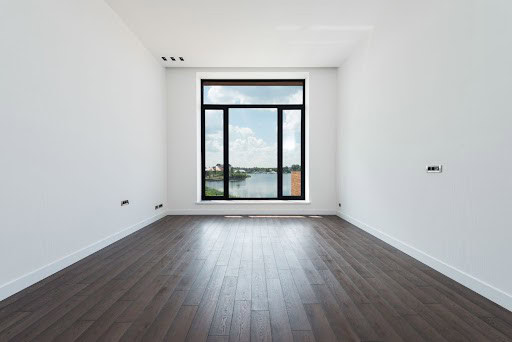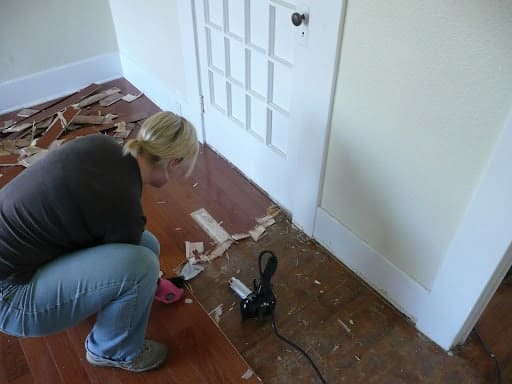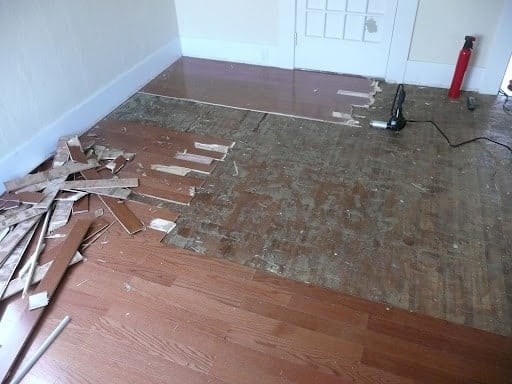The first and most important step is to vacuum the area with a HEPA vacuum to remove any loose or dry spores that could spread. Mold spores should be handled with care since they flare up your sinuses and cause mold sickness.
Mold found inside your home in places such as under the laminate flooring can cause health complications for humans and pets alike. It’s important to follow the specific steps below to remove the mold carefully and correctly.

Step 1. Protect Yourself and Your Loved Ones
Before you begin removing the mold from under the laminate flooring in your home, you need to protect yourself from being exposed to the dangerous spores.
Materials
- Goggles
- N95 or Respiratory Mask
- Rubber Gloves
- Coveralls
- Plastic sheeting
- HEPA vacuum
- Painter’s tape
Instructions
- Put on all safety equipment, including rubber gloves, goggles, masks, and coveralls.
- Ensure that pets and children are shut out of the affected room, and no one enters unless they wear protective gear.
- Use the painter’s tape and plastic sheeting to close off any openings in the room, such as archways, vents, doorways, etc.
- Vacuum the area where the mold was found with a HEPA vacuum to remove loose spores.
Step 2. Remove And Dispose Of The Laminate Floor
You will likely need to remove any laminate flooring with mold growing on it. Signs that your laminate flooring has been damaged by water and may have mold growing under it are as follows:
- Musty smell like mold or mildew
- Splits or cracks in the laminate flooring
- Buckling on the floor
- Discoloration of the flooring
- Visible mold on the floor or around the edge of it at the wall
Once you have determined that there is mold growing underneath your laminate flooring and have taken steps to protect yourself and your household, you can remove the flooring by following these steps.
You may need a putty knife to pry the flooring loose in certain spots.
- Remove furniture, curtains, rugs, etc., from the room where the mold is.
- Be sure to remain in your protective gear, and inspect the flooring to see how far the mold has spread.
- Starting from a corner in the affected area, gently pull up the laminate flooring, one panel at a time.
- In areas where you find mold growing, remove a few extra panels. This will help ensure that you have gotten all of the mold.
- If you find that the mold has spread throughout the entire room, you may need to remove the whole floor.
- Throw away the heavily contaminated panels by sealing them in plastic bags immediately.
Step 3. Clean Mold From Under The Laminate Flooring

Mold removal specialists encourage throwing away any laminate flooring that has been contaminated with mold. If you choose to save the pieces that seem treatable, you will need to clean them in the same way that you do the floor beneath. There are several methods to do so.
Cleaning Mold With Detergent And Water
One method for cleaning mold from laminate flooring uses detergent and water, although it may require vigorous scrubbing.
Materials
- Scrub brush
- One gallon of water
- One cup of detergent
- Protective gear
- Bucket
- Mop
Instructions
- While still wearing protective gear and after meticulously vacuuming the mold-infested area, mix the water and detergent into a bucket.
- Use the brush to scrub the mold from the subfloor where the laminate flooring was removed.
- Mop up the dirty water and allow the floor to completely dry. This will take from 24 to 48 hours.
Rubbing Alcohol And Vinegar To Remove Mold From Flooring
A mixture of one part water, one part vinegar, and one part alcohol may be able to kill mold with its antimicrobial properties.
Vinegar alone can kill about 80 percent of the known species of mold.
Materials
- Protective gear
- Vinegar
- Water
- Rubbing alcohol
- Bucket
- Mop
Instructions
- While wearing protective gear, mix equal parts of water, rubbing alcohol, and white vinegar in a bucket.
- Insert the mop into the vinegar solution and scrub the well-vacuumed subflooring.
- Use a soft cloth dipped into the vinegar solution to scrub hard-to-remove areas.
- Allow the area to air dry for 24 to 48 hours.
Borax And Water To Clean Mold From The Floor
You can also treat areas where mold has grown with a mixture of water and Borax. This can also be used on any of the salvageable laminate pieces.
Materials
- Protective gear
- One cup Borax
- One gallon water
- Empty spray bottle
- Funnel
- Scrub brush
- Scrub broom
Instructions
- While wearing protective gear, mix a cup of Borax and a gallon of water into a bucket.
- Funnel some of the mixtures into an empty spray bottle.
- Liberally spray the Borax mixture all over the mold-covered subflooring and laminate pieces.
- Scrub the subflooring with the scrub broom.
- Scrub the laminate pieces with the scrub brush.
- Allow the floor and laminate pieces to air dry for 24 to 48 hours.
Cleaning Mold Away With Ammonia
You can use ammonia to remove mold from any non-porous surface. It is probably not good to use this method for wooden subflooring.
Materials
- Protective gear
- One part water
- One part clear ammonia
- Bucket
- Funnel
- Empty spray bottle
Instructions
- While wearing all protective gear, take special care that goggles and a respirator mask are correctly in place.
- Pour one part ammonia and one part water into the bucket and mix well.
- Funnel the mixture into an empty spray bottle.
- Spray the solution all over the mold-infested area and allow it to air dry for several hours before rinsing it away with a damp mop.
- Allow the area to air dry for about 24 to 48 hours thoroughly.
Hydrogen Peroxide Can Also Remove Mold
Mold can also be removed with hydrogen peroxide. This method works for flooring and is also a good mold treatment on walls and furnishings.
Materials
- Protective gear
- 3 percent hydrogen peroxide
- Empty spray bottle
- Funnel
- Scrub brush
- Cloth
Instructions
- Funnel the 3 percent hydrogen peroxide solution into an empty spray bottle.
- Spray generously over the affected areas on the floor, walls, furnishings, etc., while wearing the protective gear.
- Allow it to sit for around 10 minutes.
- Scrub the mold away with the scrub brush.
- Wipe the surface with the cloth.
Bleach As A Mold Treatment
Like ammonia, bleach can be very efficient at killing mold, but may also damage flooring and is not good for the environment or your pets and family, so use it carefully.
Materials
- Protective gear
- One cup of bleach
- Four liters of water
- Bucket
- Funnel
- Empty spray bottle
- Cloths or mop
Instructions
- Liberally spray the bleach mixture onto the affected areas while wearing protective clothing and equipment.
- Wipe the mixture away using cloths or a mop, depending on where the area is.
Step 4. Treating The Rest Of The Area

No matter which method you decide to use to get rid of mold under laminate flooring, you will also have to treat the rest of the area where the mold was found.
Curtains, furnishings, walls, etc., will need to be treated for mold as mold spores have likely been spread to these areas.
You will also need to use the HEPA vacuum to clean all affected areas and furnishings.
The floor in the entire room should also be vacuumed. You should choose one of the methods mentioned above to clean the furniture, ensuring that the method is safe for that particular type of furnishings.
You can also use most of these cleaning solutions in the laundry for any curtains, clothing, and other fabrics that may have been infested with mold spores. It is also vital to find the leak which caused the mold issue.
The mold will simply return if the leak is not found and repaired.
FAQs on How To Get Rid Of Mold Under Laminate Flooring
What causes mold under laminate flooring?
The cause for mold under laminate flooring is moisture.
How can I prevent mold under laminate flooring?
You can prevent mold under laminate flooring by installing a vapor barrier or moisture barrier. If building a home in an area of high humidity, concrete slab construction is a good idea.
Will water underneath laminate flooring dry on its own?
No. If water is spilled on laminate flooring you should wipe it up immediately. If it is allowed to saturate and pool beneath the laminate flooring, it will most likely cause a mold problem.